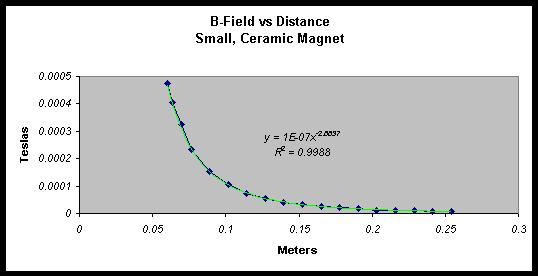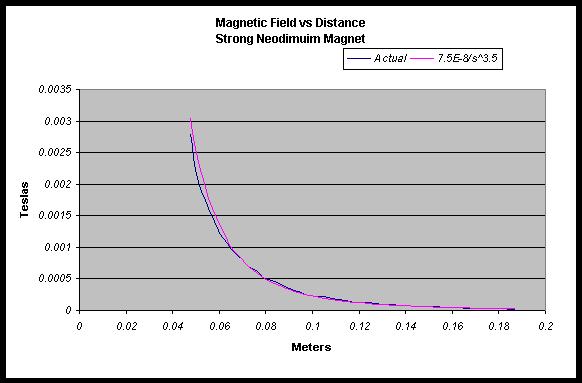| From the above graph, Graph 1.1,
of magnetic field versus distance I used the
graph-fit function to find what equation
would best fit my line. I found the most
successful graph was a power function with
the equation B=1E-07r-2.8837 with
a coefficient correlation of 99.88%. However,
Douglas Giancoli had said that the magnetic
field close to a wire is inversely
proportional to r, not r2.8837.
This makes my answer very different, but
maybe it was because the mediums (permanent
magnet versus wire) were different. Also,
when I found the magnetic fields that were
supposed to be applicable to my experiment,
they were unreasonable. For example, at my
closest distance of 2.54 mm I extrapolated a
magnetic field of 83.43 teslas from the above
equation, which is definitely unreasonable
since superconducting magnets get about 10
teslas at max. Online, I found from Field
Management Services, Inc. that the Magnetic
field versus distance for multiple conductors
is best mapped as 1/r2 and that
for loops or coils, it was best represented
by 1/r3 (Field Management
Services, Inc. [online]). I hypothesized from
this information that maybe a permanent
magnet’s field strength is best
represented by a complicated integration of
loops, coils, wires, and multiple conductors.
This makes sense since a permanent
magnet’s strength is actually based on
electron spin and electron orbital motion,
which creates a complicated mesh of minute
magnetic domains. Each of these magnetic
domains, due to their atomic structures could
have electrons moving in patterns close to
solenoids, loops of wire and other conductor
shapes. This hypothesis would justify my r-2.8837,
but what about the unreasonable calculation
from the data of 83.43 teslas. The
explanation for the large amount of teslas
from a small, ceramic magnet can be explained
by the idea that for a permanent magnet the
power to which r is taken decreases as the
magnet gets closer. Although I did not read
this anywhere, it was backed up when I
repeated the experiment for a stronger
neodymium magnet. It can also be explained by
the idea that as you get closer to a
permanent magnet the complicated loops and
coils of the magnetic domains get closer,
therefore making less curve per applicable
distance (see Diagram 1.2). This would
cause them to become closer and closer to
Giancoli’s proportion for the magnetic
field next to a straight, conducting wire,
1/r. Here is the graph of the stronger
magnet, which reinforced this belief:
|

![]()
![]() Previous____Next
Previous____Next![]()
![]()
![]()

